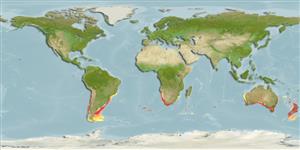>
Scombriformes (Mackerels) >
Gempylidae (Snake mackerels)
Etymology: Thyrsites: Greek, thyrsites, -ou = stalk of a plant, an ornament like a pine cone borne by Bacchus (Ref. 45335).
Environment: milieu / climate zone / depth range / distribution range
экология
морской; солоноватоводный донно-пелагический; мигрирует в океане; пределы глубины 0 - 550 m (Ref. 6390), usually 100 - 500 m (Ref. 6181). Subtropical; 13°C - 18°C (Ref. 6181); 21°S - 56°S, 75°W - 177°E (Ref. 54924)
Southwest Atlantic: Uruguay, Argentina and Tierra del Fuego. Eastern Atlantic: Tristan da Cunha and South Africa. Western Indian Ocean: South Africa and the St. Paul and Amsterdam islands. Eastern Indian Ocean: Tasmania and southern coast of Australia. Southwest Pacific: New Zealand and southern coast of Australia. Southeast Pacific: southern Peru, Chile, and Tierra del Fuego.
Length at first maturity / Size / Вес / Возраст
Maturity: Lm 55.0, range 50 - 60 cm
Max length : 200 cm SL самец/пол неопределен; (Ref. 3630); common length : 75.0 cm SL самец/пол неопределен; (Ref. 6181); наибольший вес (опубликованные данные): 6.0 kg (Ref. 6181); наибольший возраст (опубликованны данные): 10 годы (Ref. 28892)
Краткое описание
определительные ключи | морфология | морфометрия
колючие лучи спинного плавника (общее число) : 19 - 21; членистые (мягкие) лучи спинного плавника (общее число) : 11 - 13; колючие лучи анального плавника: 1; членистые (мягкие) лучи анального плавника: 10 - 12; позвонки: 35. Body elongate and strongly compressed. Lateral line single, running close to the upper contour of the body below most of the first dorsal-fin base then abruptly curving ventrally. Body is dark blue, slightly paler on belly; first dorsal fin membrane black (Ref. 6181).
Inhabit continental shelves or around islands. Feed on pelagic crustaceans (Euphausia, Nyctiphanes), cephalopods and fishes (Ref. 6181) like anchovy and pilchard (Ref. 36731). Form schools near the bottom or midwater; sometimes even at the surface at night (Ref. 6181). Prefers temperature between 13° and 18°C (Ref. 36731). Marketed fresh, smoked, canned and frozen; eaten fried, broiled, microwaved and baked (Ref. 9988). Good for fish and chips or smoking; also made into fillet or fish cake in Japan (Ref. 6181). Commonly called as Baracoutta and because it is a fast predator, several English vessels were named after it. In the UK during WW II, this canned fish was commonly eaten that many older people have an aversion to it (D. Parkyn, pers. comm. 05/2022).
Spawning patterns are complex, with different stock spawning at different times of the year (Ref. 6390).
Nakamura, I. and N.V. Parin, 1993. FAO Species Catalogue. Vol. 15. Snake mackerels and cutlassfishes of the world (families Gempylidae and Trichiuridae). An annotated and illustrated catalogue of the snake mackerels, snoeks, escolars, gemfishes, sackfishes, domine, oilfish, cutlassfishes,. scabbardfishes, hairtails, and frostfishes known to date. FAO Fish. Synop. 125(15):136 p. (Ref. 6181)
Статус Красного Списка МСОП (Ref. 130435: Version 2024-1)
Угроза для людей
Harmless
Использование человеком
рыболовство: важный объект промысла; объект спортивного рыболовства: да
дополнительная информация
инструменты
Специальные отчеты
Скачать в формате XML
ресурсы в Интернет
Estimates based on models
Preferred temperature (Ref.
123201): 6.2 - 16, mean 11.2 °C (based on 285 cells).
Phylogenetic diversity index (Ref.
82804): PD
50 = 1.0000 [Uniqueness, from 0.5 = low to 2.0 = high].
Bayesian length-weight: a=0.00437 (0.00242 - 0.00788), b=3.07 (2.90 - 3.24), in cm total length, based on LWR estimates for this species & (Sub)family-body (Ref.
93245).
Trophic level (Ref.
69278): 3.6 ±0.3 se; based on diet studies.
Generation time: 3.7 ( na - na) years. Estimated as median ln(3)/K based on 1
growth studies.
устойчивость к внешним воздействиям (Ref.
120179): средний (среднего размера), минимальное время удвоения популяции 1.4-4.4 года (tm=2-4; tmax=10).
Prior r = 0.37, 95% CL = 0.25 - 0.56, Based on 1 full stock assessment.
Fishing Vulnerability (Ref.
59153): Moderate to high vulnerability (53 of 100).
Climate Vulnerability (Ref.
125649): Moderate vulnerability (43 of 100).
Nutrients (Ref.
124155): Calcium = 27.5 [13.2, 49.7] mg/100g; Iron = 0.697 [0.342, 1.400] mg/100g; Protein = 17.9 [15.7, 19.9] %; Omega3 = 0.225 [0.130, 0.402] g/100g; Selenium = 67.6 [33.5, 135.3] μg/100g; VitaminA = 8.26 [2.93, 23.72] μg/100g; Zinc = 0.541 [0.382, 0.784] mg/100g (wet weight);
